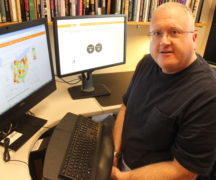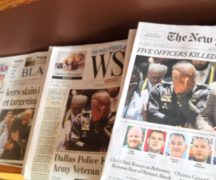By DAVID DUPONT
BG Independent News
In the wake of fatal police shootings in Charlotte, North Carolina, and Tulsa, Oklahoma, citizens are again demanding that police release the videos of the incidents.
In Charlotte, where demonstrations have been violent at times, protestors have chanted “release the tapes” of the fatal shooting of Keith Lamont Scott. (Police Saturday decided make available two videos from police cameras.)
Phil Stinson, Bowling Green State University professor in criminal justice and leading expert on policing, said he understands those calls. “I can fully understand from a point of public policy why these videos need to get out for transparency.”
However, “if I was a prosecutor I would not want these videos out before trial, certainly not before the investigation was completed,” he said. “It really does hamper the investigations when the videos get out quickly.”
Not releasing the videos “suggests that they’re not necessarily hiding something, but they are pursuing the investigation.”
What troubles Stinson is the some of the videos “show law enforcement officers acting in ways not consistent with their training.”
Often, he said, “the narrative provided by the officers on the scene and those involved in the shooting are inconsistent with the video evidence. Either they’re lying or their recollections are flawed, which is not surprising given people are not very good at remembering things.”
Stinson said it’s probably a combination of those two factors, false reports and mistaken perceptions. “An officer may believe there was an imminent threat of serious bodily injury or deadly force, but they could have been mistaken.”
Whether the shooting is justified comes down to whether that fear “is objectively reasonable,” whether an officer acting according to their training would perceive that threat.
Stinson would like to see the use of independent prosecutors for these cases. Anyone from the state attorney general’s officer down to the local prosecutor has some level of conflict of interest because of their dealings with police officers.
“It just takes away the public concern of bias and lack of impartiality,” Stinson said.
“These are ugly cases and I don’t think they are going to stop,” he said.
Support Independent News In Bowling Green
He’s been studying police shootings for 12 years, and the numbers are consistent, about 1,000 people are shot and killed by on-duty police officers every year. “It’s business as usual.”
Over that period 77 have been prosecuted for either manslaughter or murder. That includes the most recent case where Tulsa Officer Betty Shelby has been charged with manslaughter in the death of Terence Crutcher.
Of those, 26 were convicted – 13 in jury trials and 13 by guilty pleas. Another 28 were acquitted – six acquitted in in bench trials, 14 in jury trials, four cases dismissed by the judge, three dismissed by prosecutors, and one where the grand jury did not issue an indictment.
The other 23 cases are still pending.
In the first 10 years of Stinson’s data, on average 4.8 officers are charged per year. In 2015, 18 were charged, and so far this year 11 were charged. But Stinson doesn’t think that apparent spike is meaningful. “We’re dealing with outliers and a very small sample.”
The presence of video evidence is a major change in how these cases unfold. At least 11 of the cases where charges were filed last year involved some sort of video evidence.
“If one unjustifiable shooting slips by because of the lack of video evidence, that’s too much,” he said.
Still, he said, “I don’t think we’re going to see a spike where hundreds of officers are charged with murder or manslaughter. I think most shootings by police officers are justified as a matter of fact.”
These incidents take place against a back drop of a presidential election. Stinson said he’s troubled when Republican nominee Donald Trump weighs in on the guilt or innocence of a police officer while the case is still unfolding. “That seems to me foolhardy and highly inappropriate.”
Stinson didn’t give much significance to the Fraternal Order of Police endorsing Trump recently.
The last time, he noted, the FOP endorsed a Democrat was Bill Clinton in 1996, and that was after Clinton pushed through a major crime bill.
The FOP, which is as much a social organization as anything else, is “a loose-knit organization.”
“I don’t read too much into it,” Stinson said. “The membership is so varied, I don’t know that this carries much weight.”
Stinson doesn’t see Trump as having any more appeal to police than any other Republican candidate. “To me some of his statements have been so varied and off the cuff, I would think many law enforcement officers would be unsure of his policy positions should he be elected.”



